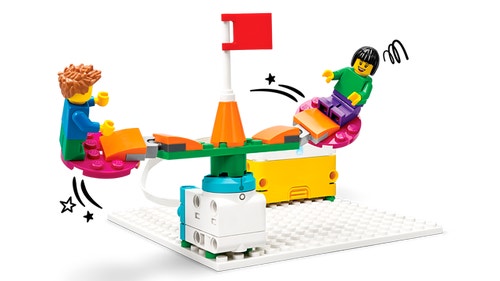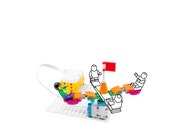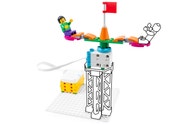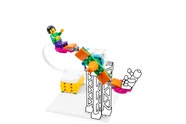SPIKE™ Essential
Classic Carousel
Create a new spinning ride for Sofie to try!
30-45 min.
Beginner
Years 1-2

Prepare
- Review the Classic Carousel lesson in the LEGO® Education SPIKE™ App.
- If you feel that it would be beneficial, pre-teach these related vocabulary words: design, improve, prototype, refine and test.
- Consider the abilities and backgrounds of all your pupils. Differentiate the lesson to make it accessible to everyone. Please refer to the Differentiation section below for suggestions on how to do this.
- If time permits, plan and facilitate the language arts extension. Please refer to the Extension section below for more information.
Engage
(Whole Class, 5 Minutes)
- Facilitate a quick discussion about making improvements to something.
- Talk with your pupils about going to an amusement park and wanting to make a fun ride even better.
- Ask questions like these: What would you do if you had the chance to change a ride? How could you change it?
- Introduce your pupils to the story’s main characters and the first challenge: making the carousel spin.
- Distribute a brick set and a device to each group.
Explore
(Small Groups, 30 Minutes)
- Have your pupils use the LEGO® Education SPIKE™ App to guide them through their first challenge:
- Create and test the program that makes the carousel spin.
- Have your pupils iterate and test their models to complete the next two challenges in the app:
- Change the program to improve the carousel.
- Upgrade the carousel for Sofie.
- You can find coding and building help in the Tips section below.
Explain
(Whole Class, 5 Minutes)
- Gather your pupils together to reflect on their completed challenges.
- Ask questions like these: How did you make the carousel spin? How did you upgrade the carousel?
Elaborate
(Whole Class, 5 Minutes)
- Prompt your pupils to discuss and reflect on the process of making improvements and refinements to something.
- Ask questions like these: What were you thinking about when you decided to improve the carousel? How did you know when you'd made enough improvements?
- Have your pupils tidy up their workstations.
Evaluate
(Ongoing Throughout the Lesson)
- Ask guiding questions to encourage your pupils to ‘think aloud’ and explain their thought processes and reasoning in the decisions they’ve made while building and programming their models.
Observation Checklist
- Measure your pupils’ proficiency in improving a prototype.
- Establish a scale that suits your needs. For example:
- Requires additional support
- Can work independently
- Can teach others
Self-Assessment
Have each pupil choose the brick that they feel best represents their performance.
- Yellow: I think that I can improve a prototype.
- Blue: I can improve a prototype.
- Green: I can improve a prototype, and I can also help a friend to do
it.
Peer Feedback
- In their small groups, have your pupils discuss their experiences working together.
- Encourage them to use statements like these:
- I liked it when you…
- I'd like to hear more about when you…
Tips
Coding Tips
- After your pupils have completed their first challenge, they'll be provided with three Inspiration Coding Blocks, which will help them to modify their programs.
- The Inspiration Coding Blocks are intended to spark their imaginations as they experiment to find their own solutions.




Model Tip
- After your pupils have completed their second challenge, they’ll be provided with three Inspiration Images and an open-ended prompt, which will help them to improve their models.
- The Inspiration Images are meant to help spark their imaginations as they experiment and change their models.




There are no specific building instructions for this challenge.
Differentiation
Simplify this lesson by:
- Shortening the lesson to include only the first challenge
- Selecting one Inspiration Image to help your pupils to change their models
Increase the difficulty by:
- Exploring new and different Coding Blocks in the program
- Adding the Colour Sensor or Light to the model
Extension
- Have your pupils write a story about Sofie’s experience at the amusement park. Ask them to include temporal words to indicate the order of events.
If facilitated, this will extend beyond the 45-minute lesson.
Language Arts: National Curriculum English En2/3.3a Develop positive attitudes towards and stamina for writing by:
writing narratives about personal experiences and those of others (real and fictional)
writing about real events
writing poetry
writing for different purposes
Teacher Support
The pupils will:
- Improve and refine a prototype as part of the design process
- Practise helping a story character
- Describe key ideas or details from a text
(one for every two pupils)
- LEGO® Education SPIKETM Essential Set
- Device with the LEGO® Education SPIKE™ App installed
National Curriculum
Design and Technology
DT1/1.1a
- design purposeful, functional, appealing products for themselves and other users based on design criteria
DT1/1.1b - generate, develop, model and communicate their ideas through talking, drawing, templates, mock-ups and, where appropriate, information and communication technology
DT1/1.2b - select from and use a wide range of materials and components, including construction materials, textiles and ingredients, according to their characteristics
DT1/1.3b - evaluate their ideas and products against design criteria
English
En2/1g
- use spoken language to develop understanding through speculating, hypothesising, imagining and exploring ideas
En2/2.2d - explain and discuss their understanding of books, poems and other material, both those that they listen to and those that they read for themselves.
En2/3.3a - Develop positive attitudes towards and stamina for writing by:
- writing narratives about personal experiences and those of others (real and fictional)
- writing about real events
- writing poetry
- writing for different purposes




